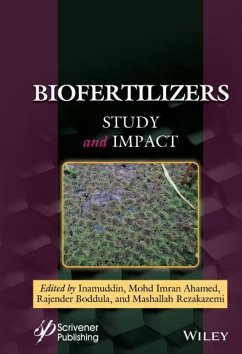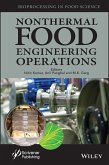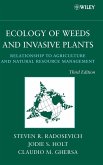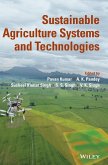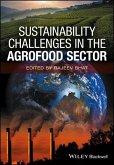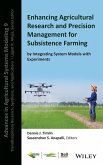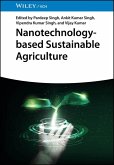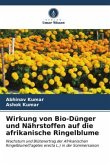I InamuddinStudy and Impact
Biofertilizers
Study and Impact
Herausgegeben:Inamuddin; Ahamed, Mohd Imran; Boddula, Rajender
I InamuddinStudy and Impact
Biofertilizers
Study and Impact
Herausgegeben:Inamuddin; Ahamed, Mohd Imran; Boddula, Rajender
- Gebundenes Buch
- Merkliste
- Auf die Merkliste
- Bewerten Bewerten
- Teilen
- Produkt teilen
- Produkterinnerung
- Produkterinnerung
Dieses Werk vermittelt umfangreiche Kenntnisse über die Geschichte und Grundlagen moderner Biodüngemittel, insbesondere über aktuelle Forschungsergebnisse, die Herausforderungen und Zukunftsperspektiven. Behandelt werden die Herstellungsprozesse sowie verschiedene Arten von Biodüngemitteln mit ihrer Anwendung in Landwirtschaft, Umweltschutz, Forstwirtschaft und der Industrie. Auch Themen wie ökologischer Landbau, Qualitätskontrolle, Qualitätssicherung, Lebensmittelsicherheit und Fallstudien über Biodüngemittel werden kurz umrissen. Gründliche Erklärungen finden sich zu den physikalischen…mehr
Andere Kunden interessierten sich auch für
![Nonthermal Food Engineering Operations Nonthermal Food Engineering Operations]() Nonthermal Food Engineering OperationsNonthermal Food Engineering Operations221,99 €
Nonthermal Food Engineering OperationsNonthermal Food Engineering Operations221,99 €![Ecology of Weeds and Invasive Plants Ecology of Weeds and Invasive Plants]() Steven R. RadosevichEcology of Weeds and Invasive Plants116,99 €
Steven R. RadosevichEcology of Weeds and Invasive Plants116,99 €![Sustainable Agriculture Systems and Technologies Sustainable Agriculture Systems and Technologies]() Sustainable Agriculture Systems and Technologies194,99 €
Sustainable Agriculture Systems and Technologies194,99 €![Sustainability Challenges in the Agrofood Sector Sustainability Challenges in the Agrofood Sector]() Sustainability Challenges in the Agrofood Sector236,99 €
Sustainability Challenges in the Agrofood Sector236,99 €![Enhancing Agricultural Research and Precision Management for Subsistence Farming by Integrating System Models with Experiments Enhancing Agricultural Research and Precision Management for Subsistence Farming by Integrating System Models with Experiments]() D TimlinEnhancing Agricultural Research and Precision Management for Subsistence Farming by Integrating System Models with Experiments130,99 €
D TimlinEnhancing Agricultural Research and Precision Management for Subsistence Farming by Integrating System Models with Experiments130,99 €![Nanotechnology-based Sustainable Agriculture Nanotechnology-based Sustainable Agriculture]() Nanotechnology-based Sustainable Agriculture111,99 €
Nanotechnology-based Sustainable Agriculture111,99 €![Wirkung von Bio-Dünger und Nährstoffen auf die afrikanische Ringelblume Wirkung von Bio-Dünger und Nährstoffen auf die afrikanische Ringelblume]() Abhinav KumarWirkung von Bio-Dünger und Nährstoffen auf die afrikanische Ringelblume60,90 €
Abhinav KumarWirkung von Bio-Dünger und Nährstoffen auf die afrikanische Ringelblume60,90 €-
-
-
Dieses Werk vermittelt umfangreiche Kenntnisse über die Geschichte und Grundlagen moderner Biodüngemittel, insbesondere über aktuelle Forschungsergebnisse, die Herausforderungen und Zukunftsperspektiven. Behandelt werden die Herstellungsprozesse sowie verschiedene Arten von Biodüngemitteln mit ihrer Anwendung in Landwirtschaft, Umweltschutz, Forstwirtschaft und der Industrie. Auch Themen wie ökologischer Landbau, Qualitätskontrolle, Qualitätssicherung, Lebensmittelsicherheit und Fallstudien über Biodüngemittel werden kurz umrissen. Gründliche Erklärungen finden sich zu den physikalischen Eigenschaften, den Einflussfaktoren, Auswirkungen und dem Branchenprofil auf dem Markt. Dieses Buch ist ein unverzichtbarer Leitfaden für Landwirte, Agrochemiker, Umweltingenieure, Wissenschaftler, Studenten und Dozenten, die sich eingängiger mit der Wissenschaft hinter nachhaltigen Düngemitteln, Bodenchemie und Agrarökologie befassen möchten.
Produktdetails
- Produktdetails
- Verlag: Wiley & Sons / Wiley-Scrivener
- Artikelnr. des Verlages: 1W119724670
- 1. Auflage
- Seitenzahl: 688
- Erscheinungstermin: 3. August 2021
- Englisch
- Abmessung: 231mm x 150mm x 38mm
- Gewicht: 1068g
- ISBN-13: 9781119724674
- ISBN-10: 1119724678
- Artikelnr.: 59760568
- Herstellerkennzeichnung
- Libri GmbH
- Europaallee 1
- 36244 Bad Hersfeld
- gpsr@libri.de
- Verlag: Wiley & Sons / Wiley-Scrivener
- Artikelnr. des Verlages: 1W119724670
- 1. Auflage
- Seitenzahl: 688
- Erscheinungstermin: 3. August 2021
- Englisch
- Abmessung: 231mm x 150mm x 38mm
- Gewicht: 1068g
- ISBN-13: 9781119724674
- ISBN-10: 1119724678
- Artikelnr.: 59760568
- Herstellerkennzeichnung
- Libri GmbH
- Europaallee 1
- 36244 Bad Hersfeld
- gpsr@libri.de
Inamuddin, PhD, is an assistant professor at the Department of Applied Chemistry, Zakir Husain College of Engineering and Technology, Faculty of Engineering and Technology, Aligarh Muslim University, Aligarh, India. He has extensive research experience in analytical chemistry, materials chemistry, electrochemistry, renewable energy, and environmental science. He has worked on different research projects funded by various government agencies and universities and is the recipient of multiple awards, including the Fast Track Young Scientist Award and the Young Researcher of the Year Award for 2020, from Aligarh Muslim University. He has published almost 200 research articles in various international scientific journals, 18 book chapters, and 120 edited books with multiple well-known publishers. Mohd Imran Ahamed, PhD, is a research associate in the Department of Chemistry, Aligarh Muslim University, Aligarh, India. He has published several research and review articles in various international scientific journals and has co-edited multiple books. His research work includes ion-exchange chromatography, wastewater treatment, and analysis, bending actuator and electrospinning. Rajender Boddula, PhD, is currently working for the Chinese Academy of Sciences President's International Fellowship Initiative (CAS-PIFI) at the National Center for Nanoscience and Technology (NCNST, Beijing). His academic honors include multiple fellowships and scholarships, and he has published many scientific articles in international peer-reviewed journals. He is also serving as an editorial board member and a referee for several reputed international peer-reviewed journals. He has published edited books with numerous publishers and has authored over twenty book chapters. Mashallah Rezakazemi, PhD, received his doctorate from the University of Tehran (UT) in 2015. In his first appointment, he served as associate professor in the Faculty of Chemical and Materials Engineering at Shahrood University of Technology. He has co-authored in more than 140 highly cited journal publications, conference articles and book chapters. He has received numerous major awards and grants from various funding agencies in recognition of his research. Notable among these are Khwarizmi Youth Award from the Iranian Research Organization for Science and Technology (IROST), and the Outstanding Young Researcher Award in Chemical Engineering from the Academy of Sciences of Iran. He was named a top 1% most Highly Cited Researcher by Web of Science (ESI).
Preface xxi
1 Biofertilizer Utilization in Forestry 1
Wendy Ying Ying Liu and Ranjetta Poobathy
1.1 Introduction 2
1.2 Mechanisms of Actions of Biofertilizers 3
1.2.1 Facilitation of N Acquisition 3
1.2.1.1 Mutualistic N2 Fixation 4
1.2.1.2 Non-Symbiotic N2 Fixation 5
1.2.2 Facilitation of P Acquisition 5
1.2.2.1 Phosphate Solubilizing Microorganisms 6
1.2.2.2 Mycorrhizas 7
1.2.3 Potassium Solubilization 8
1.2.4 Production of Siderophores 9
1.2.5 Modulation of Phytohormones 10
1.2.6 Phytoprotection 12
1.3 Factors Influencing the Outcome of Forestry-Related Biofertilizer Applications 13
1.4 Applications of Biofertilizers in Forestry 16
1.5 Conclusion and Future Prospects 18
References 20
2 Impact of Biofertilizers on Horticultural Crops 39
Clement Kiing Fook Wong and Chui-Yao Teh
2.1 Introduction 40
2.2 Microbial Strains Used in Biofertilizers 41
2.3 Impact of Biofertilizer Application on Horticultural Crops 41
2.3.1 Increased Yield and Quality of Crops 41
2.3.1.1 Vegetable Crops 44
2.3.1.2 Fruit Crops 46
2.3.1.3 Ornamental Plants 48
2.3.2 Enhanced Nutritional Content of Produce 49
2.3.2.1 Mineral-Biofortified Crops 49
2.3.2.2 Enhanced Secondary Metabolites 50
2.3.2.3 Improved Vitamin Content 51
2.3.3 Improved Tolerance Against Biotic Stress 52
2.3.3.1 Fungal and Bacterial Pathogens 52
2.3.3.2 Viral Pathogens 56
2.3.3.3 Insect Pests 58
2.3.3.4 Nematodes 61
2.3.3.5 Weeds 64
2.3.4 Improved Tolerance Against Abiotic Stress 65
2.3.4.1 Drought 66
2.3.4.2 Salinity 68
2.3.4.3 Heavy Metal 70
2.3.4.4 Cold Stress 71
2.3.4.5 Heat Stress 73
2.3.5 Improved Vegetative Propagation Efficiency 73
2.3.5.1 Propagation by Cuttings 73
2.3.5.2 Grafting 74
2.4 Future Perspectives and Challenges Ahead 75
2.5 Conclusion 79
References 79
3 N2 Fixation in Biofertilizers 105
Rekha Sharma, Sapna Nehra and Dinesh Kumar
3.1 Introduction 106
3.2 Biofertilizers 108
3.2.1 Origin 108
3.3 Biofertilizer: Transporter Constituents 108
3.4 Mechanism of Actions of Biofertilizers 109
3.5 Biochemistry of Manufacture of Biofertilizer 109
3.6 Benefits of Biofertilizer Over Biochemical Fertilizers 110
3.7 Variances Among Organic and Biofertilizer 111
3.8 Types of Biofertilizers 111
3.9 Microorganisms Utilized to Make Biofertilizer 111
3.10 Microorganism in Nitrogen Fixation 113
3.10.1 Biofertilizers: Symbiotic N-Fixers 113
3.10.2 Biofertilizers: Free Living N-Fixers 114
3.10.3 Biofertilizers: Associative Symbiotic N-Fixers 114
3.11 Phosphorus Solubilizing Microbes 115
3.12 Conclusion and Future Prospect 115
Acknowledgments 116
Abbreviations 116
References 117
4 Organic Farming by Biofertilizers 121
Anuradha and Jagvir Singh
4.1 Introduction 122
4.2 Biofertilizers 123
4.2.1 Benefits of Biofertilizers 126
4.2.2 Method of Biofertilizer Application 126
4.2.2.1 Seed Treatment 126
4.2.2.2 Seedling Treatment 127
4.2.2.3 Setts and Tuta Treatment 127
4.2.2.4 Soil Treatment 127
4.2.3 Precautions During Application of Biofertilizers 127
4.3 Classification of Biofertilizers 128<
1 Biofertilizer Utilization in Forestry 1
Wendy Ying Ying Liu and Ranjetta Poobathy
1.1 Introduction 2
1.2 Mechanisms of Actions of Biofertilizers 3
1.2.1 Facilitation of N Acquisition 3
1.2.1.1 Mutualistic N2 Fixation 4
1.2.1.2 Non-Symbiotic N2 Fixation 5
1.2.2 Facilitation of P Acquisition 5
1.2.2.1 Phosphate Solubilizing Microorganisms 6
1.2.2.2 Mycorrhizas 7
1.2.3 Potassium Solubilization 8
1.2.4 Production of Siderophores 9
1.2.5 Modulation of Phytohormones 10
1.2.6 Phytoprotection 12
1.3 Factors Influencing the Outcome of Forestry-Related Biofertilizer Applications 13
1.4 Applications of Biofertilizers in Forestry 16
1.5 Conclusion and Future Prospects 18
References 20
2 Impact of Biofertilizers on Horticultural Crops 39
Clement Kiing Fook Wong and Chui-Yao Teh
2.1 Introduction 40
2.2 Microbial Strains Used in Biofertilizers 41
2.3 Impact of Biofertilizer Application on Horticultural Crops 41
2.3.1 Increased Yield and Quality of Crops 41
2.3.1.1 Vegetable Crops 44
2.3.1.2 Fruit Crops 46
2.3.1.3 Ornamental Plants 48
2.3.2 Enhanced Nutritional Content of Produce 49
2.3.2.1 Mineral-Biofortified Crops 49
2.3.2.2 Enhanced Secondary Metabolites 50
2.3.2.3 Improved Vitamin Content 51
2.3.3 Improved Tolerance Against Biotic Stress 52
2.3.3.1 Fungal and Bacterial Pathogens 52
2.3.3.2 Viral Pathogens 56
2.3.3.3 Insect Pests 58
2.3.3.4 Nematodes 61
2.3.3.5 Weeds 64
2.3.4 Improved Tolerance Against Abiotic Stress 65
2.3.4.1 Drought 66
2.3.4.2 Salinity 68
2.3.4.3 Heavy Metal 70
2.3.4.4 Cold Stress 71
2.3.4.5 Heat Stress 73
2.3.5 Improved Vegetative Propagation Efficiency 73
2.3.5.1 Propagation by Cuttings 73
2.3.5.2 Grafting 74
2.4 Future Perspectives and Challenges Ahead 75
2.5 Conclusion 79
References 79
3 N2 Fixation in Biofertilizers 105
Rekha Sharma, Sapna Nehra and Dinesh Kumar
3.1 Introduction 106
3.2 Biofertilizers 108
3.2.1 Origin 108
3.3 Biofertilizer: Transporter Constituents 108
3.4 Mechanism of Actions of Biofertilizers 109
3.5 Biochemistry of Manufacture of Biofertilizer 109
3.6 Benefits of Biofertilizer Over Biochemical Fertilizers 110
3.7 Variances Among Organic and Biofertilizer 111
3.8 Types of Biofertilizers 111
3.9 Microorganisms Utilized to Make Biofertilizer 111
3.10 Microorganism in Nitrogen Fixation 113
3.10.1 Biofertilizers: Symbiotic N-Fixers 113
3.10.2 Biofertilizers: Free Living N-Fixers 114
3.10.3 Biofertilizers: Associative Symbiotic N-Fixers 114
3.11 Phosphorus Solubilizing Microbes 115
3.12 Conclusion and Future Prospect 115
Acknowledgments 116
Abbreviations 116
References 117
4 Organic Farming by Biofertilizers 121
Anuradha and Jagvir Singh
4.1 Introduction 122
4.2 Biofertilizers 123
4.2.1 Benefits of Biofertilizers 126
4.2.2 Method of Biofertilizer Application 126
4.2.2.1 Seed Treatment 126
4.2.2.2 Seedling Treatment 127
4.2.2.3 Setts and Tuta Treatment 127
4.2.2.4 Soil Treatment 127
4.2.3 Precautions During Application of Biofertilizers 127
4.3 Classification of Biofertilizers 128<
Preface xxi
1 Biofertilizer Utilization in Forestry 1
Wendy Ying Ying Liu and Ranjetta Poobathy
1.1 Introduction 2
1.2 Mechanisms of Actions of Biofertilizers 3
1.2.1 Facilitation of N Acquisition 3
1.2.1.1 Mutualistic N2 Fixation 4
1.2.1.2 Non-Symbiotic N2 Fixation 5
1.2.2 Facilitation of P Acquisition 5
1.2.2.1 Phosphate Solubilizing Microorganisms 6
1.2.2.2 Mycorrhizas 7
1.2.3 Potassium Solubilization 8
1.2.4 Production of Siderophores 9
1.2.5 Modulation of Phytohormones 10
1.2.6 Phytoprotection 12
1.3 Factors Influencing the Outcome of Forestry-Related Biofertilizer Applications 13
1.4 Applications of Biofertilizers in Forestry 16
1.5 Conclusion and Future Prospects 18
References 20
2 Impact of Biofertilizers on Horticultural Crops 39
Clement Kiing Fook Wong and Chui-Yao Teh
2.1 Introduction 40
2.2 Microbial Strains Used in Biofertilizers 41
2.3 Impact of Biofertilizer Application on Horticultural Crops 41
2.3.1 Increased Yield and Quality of Crops 41
2.3.1.1 Vegetable Crops 44
2.3.1.2 Fruit Crops 46
2.3.1.3 Ornamental Plants 48
2.3.2 Enhanced Nutritional Content of Produce 49
2.3.2.1 Mineral-Biofortified Crops 49
2.3.2.2 Enhanced Secondary Metabolites 50
2.3.2.3 Improved Vitamin Content 51
2.3.3 Improved Tolerance Against Biotic Stress 52
2.3.3.1 Fungal and Bacterial Pathogens 52
2.3.3.2 Viral Pathogens 56
2.3.3.3 Insect Pests 58
2.3.3.4 Nematodes 61
2.3.3.5 Weeds 64
2.3.4 Improved Tolerance Against Abiotic Stress 65
2.3.4.1 Drought 66
2.3.4.2 Salinity 68
2.3.4.3 Heavy Metal 70
2.3.4.4 Cold Stress 71
2.3.4.5 Heat Stress 73
2.3.5 Improved Vegetative Propagation Efficiency 73
2.3.5.1 Propagation by Cuttings 73
2.3.5.2 Grafting 74
2.4 Future Perspectives and Challenges Ahead 75
2.5 Conclusion 79
References 79
3 N2 Fixation in Biofertilizers 105
Rekha Sharma, Sapna Nehra and Dinesh Kumar
3.1 Introduction 106
3.2 Biofertilizers 108
3.2.1 Origin 108
3.3 Biofertilizer: Transporter Constituents 108
3.4 Mechanism of Actions of Biofertilizers 109
3.5 Biochemistry of Manufacture of Biofertilizer 109
3.6 Benefits of Biofertilizer Over Biochemical Fertilizers 110
3.7 Variances Among Organic and Biofertilizer 111
3.8 Types of Biofertilizers 111
3.9 Microorganisms Utilized to Make Biofertilizer 111
3.10 Microorganism in Nitrogen Fixation 113
3.10.1 Biofertilizers: Symbiotic N-Fixers 113
3.10.2 Biofertilizers: Free Living N-Fixers 114
3.10.3 Biofertilizers: Associative Symbiotic N-Fixers 114
3.11 Phosphorus Solubilizing Microbes 115
3.12 Conclusion and Future Prospect 115
Acknowledgments 116
Abbreviations 116
References 117
4 Organic Farming by Biofertilizers 121
Anuradha and Jagvir Singh
4.1 Introduction 122
4.2 Biofertilizers 123
4.2.1 Benefits of Biofertilizers 126
4.2.2 Method of Biofertilizer Application 126
4.2.2.1 Seed Treatment 126
4.2.2.2 Seedling Treatment 127
4.2.2.3 Setts and Tuta Treatment 127
4.2.2.4 Soil Treatment 127
4.2.3 Precautions During Application of Biofertilizers 127
4.3 Classification of Biofertilizers 128<
1 Biofertilizer Utilization in Forestry 1
Wendy Ying Ying Liu and Ranjetta Poobathy
1.1 Introduction 2
1.2 Mechanisms of Actions of Biofertilizers 3
1.2.1 Facilitation of N Acquisition 3
1.2.1.1 Mutualistic N2 Fixation 4
1.2.1.2 Non-Symbiotic N2 Fixation 5
1.2.2 Facilitation of P Acquisition 5
1.2.2.1 Phosphate Solubilizing Microorganisms 6
1.2.2.2 Mycorrhizas 7
1.2.3 Potassium Solubilization 8
1.2.4 Production of Siderophores 9
1.2.5 Modulation of Phytohormones 10
1.2.6 Phytoprotection 12
1.3 Factors Influencing the Outcome of Forestry-Related Biofertilizer Applications 13
1.4 Applications of Biofertilizers in Forestry 16
1.5 Conclusion and Future Prospects 18
References 20
2 Impact of Biofertilizers on Horticultural Crops 39
Clement Kiing Fook Wong and Chui-Yao Teh
2.1 Introduction 40
2.2 Microbial Strains Used in Biofertilizers 41
2.3 Impact of Biofertilizer Application on Horticultural Crops 41
2.3.1 Increased Yield and Quality of Crops 41
2.3.1.1 Vegetable Crops 44
2.3.1.2 Fruit Crops 46
2.3.1.3 Ornamental Plants 48
2.3.2 Enhanced Nutritional Content of Produce 49
2.3.2.1 Mineral-Biofortified Crops 49
2.3.2.2 Enhanced Secondary Metabolites 50
2.3.2.3 Improved Vitamin Content 51
2.3.3 Improved Tolerance Against Biotic Stress 52
2.3.3.1 Fungal and Bacterial Pathogens 52
2.3.3.2 Viral Pathogens 56
2.3.3.3 Insect Pests 58
2.3.3.4 Nematodes 61
2.3.3.5 Weeds 64
2.3.4 Improved Tolerance Against Abiotic Stress 65
2.3.4.1 Drought 66
2.3.4.2 Salinity 68
2.3.4.3 Heavy Metal 70
2.3.4.4 Cold Stress 71
2.3.4.5 Heat Stress 73
2.3.5 Improved Vegetative Propagation Efficiency 73
2.3.5.1 Propagation by Cuttings 73
2.3.5.2 Grafting 74
2.4 Future Perspectives and Challenges Ahead 75
2.5 Conclusion 79
References 79
3 N2 Fixation in Biofertilizers 105
Rekha Sharma, Sapna Nehra and Dinesh Kumar
3.1 Introduction 106
3.2 Biofertilizers 108
3.2.1 Origin 108
3.3 Biofertilizer: Transporter Constituents 108
3.4 Mechanism of Actions of Biofertilizers 109
3.5 Biochemistry of Manufacture of Biofertilizer 109
3.6 Benefits of Biofertilizer Over Biochemical Fertilizers 110
3.7 Variances Among Organic and Biofertilizer 111
3.8 Types of Biofertilizers 111
3.9 Microorganisms Utilized to Make Biofertilizer 111
3.10 Microorganism in Nitrogen Fixation 113
3.10.1 Biofertilizers: Symbiotic N-Fixers 113
3.10.2 Biofertilizers: Free Living N-Fixers 114
3.10.3 Biofertilizers: Associative Symbiotic N-Fixers 114
3.11 Phosphorus Solubilizing Microbes 115
3.12 Conclusion and Future Prospect 115
Acknowledgments 116
Abbreviations 116
References 117
4 Organic Farming by Biofertilizers 121
Anuradha and Jagvir Singh
4.1 Introduction 122
4.2 Biofertilizers 123
4.2.1 Benefits of Biofertilizers 126
4.2.2 Method of Biofertilizer Application 126
4.2.2.1 Seed Treatment 126
4.2.2.2 Seedling Treatment 127
4.2.2.3 Setts and Tuta Treatment 127
4.2.2.4 Soil Treatment 127
4.2.3 Precautions During Application of Biofertilizers 127
4.3 Classification of Biofertilizers 128<

